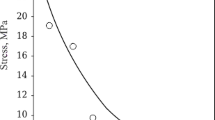Abstract
The effect of activating additives of H3PO4 and zirconium oxychloride and a sintering additive of A12O3 on the properties of zirconia concrete mixtures containing colloidal suspensions and vibroshaped articles on their base is described. The optimum amounts of the additives and the principal physicomechanical properties of the articles are determined. The effect of the heat treatment temperature of zirconia vibroshaped specimens and articles is studied and the optimum firing temperature is established to be no lower than 1400°C. A pilot batch of large vessels for installations for nickel evaporation has been manufactured and tested.
Similar content being viewed by others
References
V. V. Primachenko, N. V. Pitak, L. M. Kolesnikov, and T. A. Zadorozhnaya, “Studies of the production of large alumosilicate refractories by the method of vibrocasting,” in:Production of Special Refractories, Thematical Collection of the Ministry of Ferrous Metallurgy of the USSR [in Russian], Metallurgiya, Moscow (1978), pp. 58–62.
V. V. Primachenko, “Results of scientific research — to production,”Ogneupory, No. 11, 39–41 (1987).
Yu. E. Pivinskii, “Refractory concretes of the new generation. Rheological aspects of the technology,”Ogneupory, No. 4, 6–15(1984).
I. I. Nemets, N. S. Belmaz, and A. N. Semochkina, “Tribochemical activation of polycrystalline oxides of aluminum and zirconium in hydrodispersions,”Ogneupory, No. 6, 7–11(1991).
Yu. E. Pivinskii, “Cast oxide refractories with a granular structure. Sintering, structure and properties,”Ogneupory, No. 7, 10–16(1985).
Yu. E. Pivinskii, “Highly concentrated ceramic binding suspensions (HCBS). Initial materials, Properties and classification,”Ogneupory, No. 4, 8–20 (1987).
Yu. E. Pivinskii,Ceramic Binders and Ceramic Concretes [in Russian], Metallurgizdat, Moscow (1990).
A. G. Karaulov, “Zirconia ramming mixtures on orthophosphoric acid,”Ogneupory, No. 7, 40–46 (1979).
A. G. Karaulov and T. V. Piskun, “Thermal insulation powders from monoclinic zirconia,”Ogneupory, No. 7, 43–44 (1985).
N. V. Gul’ko, A. G. Karaulov, and T. E. Sudarkina, “Formation of minerals in zirconia refractories on a phosphate binder,” in:An Experimental Study of Formation of Minerals [in Russian], Nauka, Moscow (1972), pp. 373–378.
P. P. Budnikov and L. B. Khoroshavin,Refractory Concretes on Phosphate Binders [in Russian], Metallurgiya, Moscow (1971).
V. A. Kopeikin, “Phosphate binders and materials on their base,”Zh. VKhO Mendeleeva, X(2), 179–183 (1975).
S. L. Golynko-Volfson, M. I. Sychev, L. G. Sudakas, and A. I. Skoblova,Chemical Foundations of the Technology and Application of Phosphate Binders and Coats [in Russian], Khimiya, Moscow (1968).
Author information
Authors and Affiliations
Rights and permissions
About this article
Cite this article
Karaulov, A.G., Chudnova, N.M. & Pashchenko, N.V. Advancing the manufacturing process of zirconia vessels for installations for nickel evaporation. Refract Ind Ceram 39, 246–248 (1998). https://doi.org/10.1007/BF02765075
Issue Date:
DOI: https://doi.org/10.1007/BF02765075



